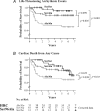Junctin and the histidine-rich Ca2+ binding protein: potential roles in heart failure and arrhythmogenesis
- PMID: 19403607
- PMCID: PMC2727024
- DOI: 10.1113/jphysiol.2009.172171
Junctin and the histidine-rich Ca2+ binding protein: potential roles in heart failure and arrhythmogenesis
Abstract
Contractile dysfunction and ventricular arrhythmias associated with heart failure have been attributed to aberrant sarcoplasmic reticulum (SR) Ca(2+) cycling. The study of junctin (JCN) and histidine-rich Ca(2+) binding protein (HRC) becomes of particular importance since these proteins have been shown to be critical regulators of Ca(2+) cycling. Specifically, JCN is a SR membrane protein, which is part of the SR Ca(2+) release quaternary structure that also includes the ryanodine receptor, triadin and calsequestrin. Functionally, JCN serves as a bridge between calsequestrin and the Ca(2+) release channel, ryanodine receptor. HRC is a SR luminal Ca(2+) binding protein known to associate with both triadin and the sarcoplasmic reticulum Ca(2+)-ATPase, and may thus mediate the crosstalk between SR Ca(2+) uptake and release. Indeed, evidence from genetic models of JCN and HRC indicate that they are important in cardiophysiology as alterations in these proteins affect SR Ca(2+) handling and cardiac function. In addition, downregulation of JCN and HRC may contribute to Ca(2+) cycling perturbations manifest in the failing heart, where their protein levels are significantly reduced. This review examines the roles of JCN and HRC in SR Ca(2+) cycling and their potential significance in heart failure.
Figures




Comment in
-
Calsequestrin, triadin and more: the molecules that modulate calcium release in cardiac and skeletal muscle.J Physiol. 2009 Jul 1;587(Pt 13):3069-70. doi: 10.1113/jphysiol.2009.175083. J Physiol. 2009. PMID: 19567746 Free PMC article. No abstract available.
-
Silencing genes of sarcoplasmic reticulum proteins clarifies their roles in excitation-contraction coupling.J Physiol. 2009 Jul 1;587(Pt 13):3089-90. doi: 10.1113/jphysiol.2009.171835. J Physiol. 2009. PMID: 19567747 Free PMC article. No abstract available.
-
Junctin - the quiet achiever.J Physiol. 2009 Jul 1;587(Pt 13):3135-7. doi: 10.1113/jphysiol.2009.171959. J Physiol. 2009. PMID: 19567751 Free PMC article. Review. No abstract available.
References
-
- Arvanitis DA, Sanoudou D, Kolokathis F, Vafiadaki E, Papalouka V, Kontrogianni-Konstantopoulos A, Theodorakis GN, Paraskevaidis IA, Adamopoulos S, Dorn GW, 2nd, Kremastinos DT, Kranias EG. The Ser96Ala variant in histidine-rich calcium-binding protein is associated with life-threatening ventricular arrhythmias in idiopathic dilated cardiomyopathy. Eur Heart J. 2008;29:2514–2525. - PMC - PubMed
-
- Arvanitis DA, Vafiadaki E, Fan GC, Mitton BA, Gregory KN, Del Monte F, Kontrogianni-Konstantopoulos A, Sanoudou D, Kranias EG. Histidine-rich Ca-binding protein interacts with sarcoplasmic reticulum Ca-ATPase. Am J Physiol Heart Circ Physiol. 2007;293:H1581–H1589. - PubMed
-
- Bers DM. Cardiac excitation-contraction coupling. Nature. 2002;415:198–205. - PubMed
-
- Bristow MR, Ginsburg R, Minobe W, Cubicciotti RS, Sageman WS, Lurie K, Billingham ME, Harrison DC, Stinson EB. Decreased catecholamine sensitivity and β-adrenergic-receptor density in failing human hearts. N Engl J Med. 1982;307:205–211. - PubMed
-
- Chu G, Kranias EG. Phospholamban as a therapeutic modality in heart failure. Novartis Found Symp. 2006;274:156–171. - PubMed
Publication types
MeSH terms
Substances
Grants and funding
LinkOut - more resources
Full Text Sources
Medical
Molecular Biology Databases
Research Materials
Miscellaneous

